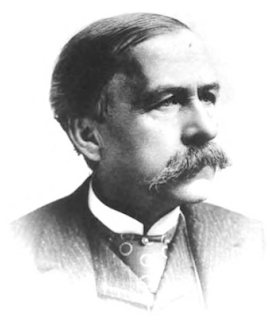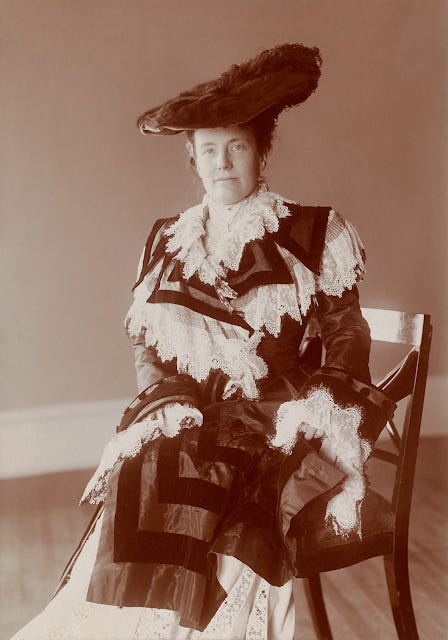Mary Scott Townsend: The Dictator of Washington's High Society
Mary Scott Townsend was born in Erie, Pennsylvania on July 7, 1854. She was the eldest of two daughters of William Lawrence Scott, a Pennsylvania railroad and coal magnate, and a two-term Democratic member of Congress (1885-89). In 1879, Mary married Richard Townsend, president of the Erie and Pittsburgh Railroad.
Although the Townsends hailed from Erie, Pennsylvania, the family was no stranger to Washington. William Lawrence Scott was born in 1828 in Washington, and was the son of Colonel Robert Scott of Virginia, a graduate of the United States Military Academy at West Point, who was detailed to the nation's capital at the time of his son's birth. As a teenager, William served served as a page in United States House of Representatives. His grandfather, Gustavus Scott, was a lawyer from Maryland whom President Washington appointed as one of the first Commissioners of the City of Washington. In 1795, Gustavus Scott bought the house and part of the Kalorama estate belonging to Anthony Holmead, one of the original proprietors of Washington who sold land to the government to create the capital city. The part of Holmead's Kalorama estate that Scott purchased stretched as far south as Massachusetts Avenue in the Dupont Circle neighborhood.
William Scott purchased the house at 736 (now number 22) Jackson Place on Lafayette Square during his second term in Congress. Upon Scott's death in 1891, having inherited part of her father's massive fortune (at the time of his death, estimated at $15,000,000, equivalent to $426,833,333 today), as well as the house on Lafayette Square, the Townsends decided to make the move to Washington, take up residence in her father’s old house, and establish themselves in high society.
The Townsends had certainly picked the area that was once the center of official society in the early days of the city, but times had changed. While official society still recognized Lafayette Square as home, most had relocated to the Scott Circle neighborhood. The Cave Dwellers had all but disappeared and their small, intimate receptions and dinners, suited to their smaller homes around the square, were no longer fashionable. Large dinner parties and lavish balls of the "unofficial" society, or the millionaire "Smart Set," were all the rage when the Townsend's arrived in Washington. But, such events required much larger homes than the Townsend's.
In 1895, the Townsends contracted the New York architectural firm of Carrere & Hastings to undertake an interior renovation and addition to their house in order to accommodate a ball room. To make room for the addition, they purchased part of the public alley behind the house from the DC government. But in the end, the enlarged house still did not provide enough space to meet their entertaining needs, and Mary began the search for a larger property elsewhere as Lafayette Square did not provide the open space they would need for the grand home they wanted.
In 1898, the Townsend's eyes turned to Dupont Circle and Curtis Hillyer’s mansion on Massachusetts Avenue. They were probably not so much attracted to the house itself– it was not any larger or newer than their current house– but it was in the center of Washington's Smart Set neighborhood where Mary decided she wanted to be. Another factor about the Hillyer mansion site was that it was on the former Holmead property purchased by Mary's great-grandfather, Gustavus Scott.
The original plan was to raze the old Hillyer mansion and build a new, grand mansion. But as a girl, Mary apparently had met with a fortune teller who warned her never to sleep under a new roof or she would die within the year. Whether or not the part about the fortune teller is true, Mary did have a self-avowed fear of living in a new house. This superstition may have extended to others beyond Mary in Washington. When Edson Bradley bought the Gardiner Green Hubbard mansion on Dupont Circle, instead of razing it, he simply added on to the old-fashioned building.
To mitigate Mary's superstition about living in a new house, rather than tearing the Hillyer mansion down and building new, they would simply build around the old house. In 1899, they again retained the architectural firm of Carrere and Hastings to remodel and expand the house, as well as Fredrick Law Olmstead, Jr. to design the gardens once the house was completed. Mary certainly must not have known about Bessie Hillyer's suicide in the house in 1888 or she might not have gone through with her plans.
Under the Townsends’ direction, the Hillyer house went through a complete transformation. The high steps leading to the main entrance were removed, and the new entrance was placed on street level. The interior was entirely renovated, leaving nothing of the old house except the exterior walls. Two large wings were added on the east and west sides of the house to accommodate a spacious ballroom and library. The front and back were also added on to and completely faced in Indiana limestone.
In the end, no part of the original Hillyer house was visible, except for the shape of the original house and its Mansard roof that served as the center block for the new house. When finished in 1900, the Second Empire–style Hillyer house became a grand statement of the Beaux Arts style, and temporarily at least, the most glamorous house in the city.
Yet, that must have been enough of the remains of the old house to put Mary mind at rest about her fear of dying as a result of living in a new house. Unfortunately, Mary successful conquering of her superstition did not apply to her husband. Richard was thrown from a horse near Cleveland Park in Rock Creek Park and died from a skull fracture in 1902, shortly after the house was completed.
Mary was not deterred by her sudden widowhood. She was going to use her new house for its intended purposes and her entertaining schedule remained in full steam, attracting the most brilliant and cosmopolitan people in the city with her magnetic personality. Like Mary Leiter, she entertained with elaborate ceremony, and her elegant sit-down dinners for one hundred guests at a time were not to be equaled. She is said to have spent as much as $240,000 a year (about $6 million in today’s dollars) running the house and entertaining.
Mary had a reputation of society's matchmaker for the younger members of the smart set. She played matchmaker to the married German ambassador Count Johann Heinrich von Bernstorff and often made her house available for his various trysts, which included the married Cissy Patterson. At one of her parties, Mary introduced Alice Roosevelt’s future husband, Nicholas Longworth, to her own daughter Mathilde saying to her, “Be careful, he’s dangerous.” She then turned to Longworth and said, “And you be careful because she’s very dangerous.”
Mary was referred to as the "Dictator of High Society," but she never reached her goal of rising to the top of "official society" where she so wanted to be. Even with her great-grandfather Gustavus Scott holding one of the earliest presidential appointments in Washington, and her father's two terms in congress, along with the right house in the right neighborhood, and keeping the family surname Scott along with her married name, it was all still not enough to pass the status of official society onto Mary. Although she could always attract members of official society to her events, she would always be viewed as "new money" to the city's established elites.
First Lady Edith Roosevelt took it upon herself to become the leader of official society, organizing the wives of the cabinet officers and trying to govern the moral conduct of Washington society through their guest lists. She had a particular suspicion of the millionaire smart set and its attempts to rule capital society. In 1907, the Albuquerque Evening Citizen declared Edith the recognized leader of official society, the "victor" at the end of that year's social season:
"The wife of the president still rules. She has all winter long refused to recognize any claims of self-made leaders of "unofficial" society, The people who have millions and little more have invariably been excluded from her smaller dinner parties. She has even shown great reluctance to include them in her levees...Mrs. Mary Scott Townsend, one the the heirs of the multi-millionaire Congressman Scott of Erie, aspired [to lead], but she still aspires." Albuquerque Evening Citizen, March 13, 1907.
While never fully accepted by official society, Mary did rise to the top of the smart set. When Mary Leiter passed away in 1912, the torch as the leader of the smart set was passed to Mary, but that tenure was to be short lived. Dupont Circle's Gilded Age was drawing to a quick close, and along with it the opulent and exuberant lifestyles of the smart set.
Due to failing health, Mary eventually stopped entertaining on a grand scale. She would still entertain friends, and began taking extended trips abroad to benefit from spas. In September 1912, the Salt Lake Tribune ran a story describing the Townsend home as seemingly deserted with the windows and doors boarded up, the statues flanking the entrance boxed, and the gardens showing signs of neglect. Whatever the situation was with the closed-up appearance of the house, Mary would continue to call the house home until her death in 1931.
The Townsends’ only child, Mathilde (named after Mary's mother Mathilda), was a close friend of Alice Roosevelt (Longworth) and Marguerite Cassini and was one of Dupont Circle’s social brat pack. Mathilde’s first marriage in 1910 to Rhode Island senator Peter Goelet Gerry ended in divorce in 1925. Gerry would later marry Edith Stuyvesant Dresser Vanderbilt, the widow of George Vanderbilt.
Two years after her divorce from Peter Gerry in 1925, Mathilde Townsend married Sumner Welles. Welles would later become undersecretary of state during the Franklin Roosevelt administration. The couple lived in the house at 2121 Massachusetts Avenue along with Mary Townsend.
Mary Townsend died in March 1931 after suffering from a long illness. She was buried in Erie, Pennsylvania where her mother, father, husband, and other family members are buried. In his biography of his father, Benjamin Welles remembered living in the grand mansion after his grandmother's death in 1931:
"With her death, the great mansion on Massachusetts Avenue became more sepulchral than ever, its tapestried salons and marbled halls silent except for the ticking of ornamental clocks or the low, canonical tones of the English butler, Frederick, responding to telephone inquiries."
Mathilde and Sumner Welles continued to occupy the house at 2121 Massachusetts Avenue until the Second World War when the American Women’s Volunteer Service, following the example set by Isabel Anderson across the street during the First World War, when the mansion’s stables were used for canteen preparations. In 1943, the Townsend house was occupied by the headquarters detachment of the Canadian Women’s Army Corps.
After the war, the Welles spent most of their time at their forty-nine-room “country cottage” known as Oxon Hill Manor, situated on 245 acres in Prince George’s County, Maryland, and designed by Jules Henri de Sibour. Mathilde died in 1949 and with no direct descendants of her own, her estate sold the house at 2121 Massachusetts Avenue to the Cosmos Club in 1950. At one point, Mathilde was offered $1,000,000 by the French government for the house, but at that time she turned it down. The Cosmos Club ultimately ended up acquiring it for only $365,000.












